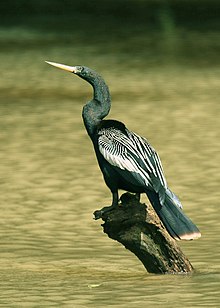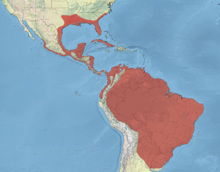Plotus anhinga
| Anhinga | |
|---|---|
 |
|
| Male in Costa Rica | |
| Scientific classification | |
| Kingdom: | Animalia |
| Phylum: | Chordata |
| Class: | Aves |
| Order: | Suliformes |
| Family: | Anhingidae |
| Genus: | Anhinga |
| Species: | A. anhinga |
| Binomial name | |
|
Anhinga anhinga (Linnaeus, 1766) |
|
| Subspecies | |
|
A. a. anhinga |
|
 |
|
| Range of A. anhinga Breeding range Resident range | |
| Synonyms | |
|
Plotus anhinga |
|
A. a. anhinga
A. a. leucogaster
Plotus anhinga
The anhinga (/ænˈhɪŋɡə/; Anhinga anhinga), sometimes called snakebird, darter, American darter, or water turkey, is a water bird of the warmer parts of the Americas. The word anhinga comes from the Brazilian Tupi language and means devil bird or snake bird. When swimming the origin of the name snakebird is apparent: only the colored neck appears above water so the bird looks like a snake ready to strike. They do not have external nares (nostrils) and breathe solely through their epiglottis.
The anhinga is placed in the darter family, Anhingidae, and is closely related to Indian (Anhinga melanogaster), African (A. rufa), and Australian (A. novaehollandiae) darters. Like other darters, the anhinga hunts by spearing fishes and other small prey using its sharp, slender beak.
Anhinga species are found all over the world in warm shallow waters. The American anhinga has been subdivided into two subspecies, A. a. anhinga and A. a. leucogaster, based on their location. A. a. anhinga can be found mainly east of the Andes in South America and also the islands of Trinidad and Tobago. A. a. leucogaster can be found in the southern United States, Mexico, Cuba, and Grenada. A fossil species Anhinga walterbolesi has been described from the Late Oligocene to Early Miocene of Australia.
...
Wikipedia

